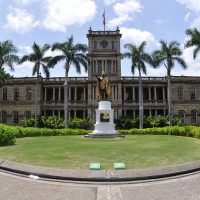In the wake of the supreme court decision on the TMT conservation district use permit last month, many like myself have been reading the opinions of the court. I was pleased to see that the justices were very clear in their views, there is very little room for any future legal steps in this case. This decision sets clear precedents for future land use cases that will certainly occur over the same issues.

In addition to the majority opinion you may read the quite interesting concurring opinion by Justice Pollack. He agrees with the majority on the final result, but promotes using existing frameworks to judge land use cases such as this. It is also interesting the dissenting Justice Wilson joins in this concurring opinion, at least for the first three parts.
The dissent written by Associate Justice Michael Wilson was published almost two weeks later than the majority opinion. The reason for this delay is not given, it is possibly a result of Justice Wilson analyzing the majority opinion and responding to it in his dissent.
As is often the case with decisions like this, it is more interesting to read the dissent than the majority opinion. Any flaws or weaknesses in the case can be examined and can be more informative. This case is an exception to that, the dissent is interesting, if for somewhat different reasons.
One of the major arguments Justice Wilson makes in the dissent, a full six pages of the 37 page dissent are devoted to the ‘Polluter Pays’ principle. The justice goes on to use examples of extreme cases such as tanneries and smelters that can and do substantially damage the surrounding environment. How is this even relevant?
Polluter Pays is applicable in the case of measurable environmental damage for which a cost can be calculated. The TMT will discharge no toxic wastes into the summit environment and is thus not even remotely comparable to any of the cases Justice Wilson cites.
The observatories do pay much of the costs associated with managing the mountain. The Mauna Kea Support Services budget comes largely from observatory funds. The observatories have also committed to demolition and site restoration costs once each facility is closed. This includes identifying and committing the funding needed to do so.

Another major section to Justice Wilson’s arguments are on the ‘Regression Principle’ the principle that the conservation district not be subjected to further degradation of the resource. This is the crux of the entire case, is the use consistent with a conservation district?

The TMT facility is being held to a higher standard during the design and construction. As part of the process several existing facilities must be removed to reduce the overall impact to the summit. The result will be a smaller footprint on the summit, and in particular on the areas closer to the true summit. Thus the concept of conservation is fulfilled.
It is important to note that the relevant laws specifically allow development in a conservation district. This may be contrary to what many perceive as a conservation district. The fact that the land in question lies inside such a district does not preclude development, it simply subjects any development to a much higher level of scrutiny and demands additional requirements.
…the impacts from TMT—a proposed land use that eclipses all other telescopes in magnitude… – Justice Wilson in the TMT Decision dissent, page 36
The statement above reveals the extent to which Justice Wilson either did not examine or ignores the evidence in the case… The TMT may seem larger, but in all practical measurements of impact such as site area, roadways, presence on the mauna, the TMT impact will not be significantly larger than some of the existing facilities. Indeed, due to a number of aspects such as the site choice, the zero discharge design, the TMT will actually have a smaller impact to the summit environment, particularly when compared with the existing large facilities located on the summit ridge.
When placed in context of retiring other facilities, the off summit site, and the new design, the overall impact to the mauna will be reduced in the course of this project. This was the crux of the UH and BLNR analysis in the course of approving the CDUP, one would be oblivious to miss it.

The evidence and testimony provided on cultural use by telescope opponents was a confusing melange of historical and present use of the summit region for cultural practice. It is in addressing this subject we also witnessed some of the most outlandish claims and distortions presented as sworn testimony by religious practitioners.
In the face of this conflicting mess of good evidence, unsupported testimony, wild distortions and outright lies concerning the cultural use of the mauna, what it the correct decision? The court majority took the correct course in reaffirming the DLNR action, in that a narrow definition of cultural practice is necessary. This agrees with decades of precedence set by various courts that have resulted from the conflict of religion with secular use of the land.
As discussed earlier, however, there was no actual evidence of use of the TMT Observatory site and Access Way area by Native Hawaiian practitioners. Furthermore, in general, astronomy and Native Hawaiian uses on Mauna Kea have co-existed for many years and the TMT Project will not curtail or restrict Native Hawaiian uses. – Hawaii State Supreme Court decision for the TMT CDUP, page 51
While telescope opponents have made the argument that the majority opinion was preconceived and written to achieve a desired result. I would argue that this seems exactly what was done with Justice Wilson’s dissent. The justice found it necessary to overreach and use inapplicable case law to support his decision against. The use of ‘Polluter Pays’ as an argument in the dissent being a glaring example of this.
As the original decision was 4-1 in this ruling I do not expect a review to be real option for opponents in this case. Telescope opponents have a short time left to file for such re-consideration and I am sure they will. As to whether the reconsideration request meets with any success is yet to be seen.


Interesting review of the case. I only hope the wonder of the mauna can be reachieved after years of strife have mentally poluted the place for me. Its like going diving knowing u will be stung or bitten. Imho.
Aloha